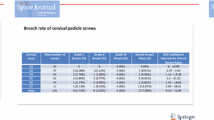Abstract
Purpose
Evaluate the accuracy of five different techniques for lower cervical pedicle screw placement.
Methods
Forty human cadaveric cervical spines were equally divided into five groups, and each group had eight specimens. Pedicle screws with dia. 3.5 mm were used. Group 1 was blind screw placement without any assistance; Group 2–5 was assisted by the X-ray fluoroscopy, virtual fluoroscopy navigation system, CT-based navigation system, and Iso-C 3D navigation system, respectively. Thereafter, cortical integrity of each pedicle was evaluated by anatomic dissection of the specimens.
Results
A total of 398 pedicle screws were inserted. In the Group 1–5, the average operation time per sample was 27 ± 3.0, 112 ± 10.3, 69 ± 6.4, 98 ± 11.0, and 91 ± 6.0 min, respectively. The outcome for excellent, fair and poor were 29 (36.3 %), 21 (26.2 %) and 30 (37.5 %) in Group 1; 35 (44.9 %), 29 (37.2 %) and 14 (17.9 %) in Group 2; 34 (42.5 %), 36 (45.0 %) and 10 (12.5 %) in Group 3; 70 (87.5 %), 10 (12.5 %) and 0 (0.0 %) in Group 4; 72 (90.0 %), 8 (10.0 %) and 0 (0.0 %) in Group 5.
Conclusions
Blind screw placement was surely unsafe. Lower cervical pedicle screw placement assisted by the CT-based navigation system or the Iso-C 3D navigation system significantly improved the accuracy compared to the fluoroscopy assistance and the virtual fluoroscopy navigation assistance.





Similar content being viewed by others
References
Barnes AH, Eguizabal JA, Acosta FL Jr, Lotz JC, Buckley JM, Ames CP (2009) Biomechanical pullout strength and stability of the cervical artificial pedicle screw. Spine (Phila Pa 1976) 34(1):E16–E20. doi:10.1097/BRS.0b013e3181891772
Dunlap BJ, Karaikovic EE, Park HS, Sokolowski MJ, Zhang LQ (2010) Load sharing properties of cervical pedicle screw-rod constructs versus lateral mass screw-rod constructs. Eur Spine J 19(5):803–808. doi:10.1007/s00586-010-1278-0
Xu R, Ebraheim NA, Skie M (2008) Pedicle screw fixation in the cervical spine. Am J Orthop (Belle Mead NJ) 37(8):403–408 discussion 408
Miyamoto H, Uno K (2009) Cervical pedicle screw insertion using a computed tomography cutout technique. J Neurosurg Spine 11(6):681–687. doi:10.3171/2009.6.SPINE09352
Abumi K, Shono Y, Ito M, Taneichi H, Kotani Y, Kaneda K (2000) Complications of pedicle screw fixation in reconstructive surgery of the cervical spine. Spine (Phila Pa 1976) 25(8):962–969
Yukawa Y, Kato F, Ito K, Horie Y, Hida T, Nakashima H, Machino M (2009) Placement and complications of cervical pedicle screws in 144 cervical trauma patients using pedicle axis view techniques by fluoroscope. Eur Spine J 18(9):1293–1299. doi:10.1007/s00586-009-1032-7
Tjardes T, Shafizadeh S, Rixen D, Paffrath T, Bouillon B, Steinhausen ES, Baethis H (2010) Image-guided spine surgery: state of the art and future directions. Eur Spine J 19(1):25–45. doi:10.1007/s00586-009-1091-9
Verma R, Krishan S, Haendlmayer K, Mohsen A (2010) Functional outcome of computer-assisted spinal pedicle screw placement: a systematic review and meta-analysis of 23 studies including 5,992 pedicle screws. Eur Spine J 19(3):370–375. doi:10.1007/s00586-009-1258-4
Han W, Gao ZL, Wang JC, Li YP, Peng X, Rui J, Jun W (2010) Pedicle screw placement in the thoracic spine: a comparison study of computer-assisted navigation and conventional techniques. Orthopedics 33(8). doi:10.3928/01477447-20100625-14
Rajasekaran S, Vidyadhara S, Ramesh P, Shetty AP (2007) Randomized clinical study to compare the accuracy of navigated and non-navigated thoracic pedicle screws in deformity correction surgeries. Spine (Phila Pa 1976) 32(2):E56–E64. doi:10.1097/01.brs.0000252094.64857.ab
Kosmopoulos V, Schizas C (2007) Pedicle screw placement accuracy: a meta-analysis. Spine (Phila Pa 1976) 32(3):E111–E120. doi:10.1097/01.brs.0000254048.79024.8b
Biswas D, Bible JE, Bohan M, Simpson AK, Whang PG, Grauer JN (2009) Radiation exposure from musculoskeletal computerized tomographic scans. J Bone Joint Surg Am 91(8):1882–1889. doi:10.2106/jbjs.h.01199
Tian W, Weng C, Liu B, Li Q, Hu L, Li ZY, Liu YJ, Sun YZ (2012) Posterior fixation and fusion of unstable Hangman’s fracture by using intraoperative three-dimensional fluoroscopy-based navigation. Eur Spine J 21(5):863–871
Tian W, Lang Z (2010) Placement of pedicle screws using three-dimensional fluoroscopy-based navigation in lumbar vertebrae with axial rotation. Eur Spine J. 19(11):1928–1935
Tian W, Liu YJ (2010) Intraoperative 3D C-arm and navigation opened a new era in spine surgery—analysis of 818 cases of navigation assisted spine surgery. In: The 7th annual meeting of CAOS-Asia, Thailand
Acknowledgments
This work was supported by a grant from the Beijing Nova Program (2007B023 to Yajun Liu), which is funded by Beijing municipal science and technology commission for science and technology talent cultivation plan.
Conflict of interest
None.
Author information
Authors and Affiliations
Corresponding author
Additional information
W. Tian and Y. Liu contributed equally to this work.
Rights and permissions
About this article
Cite this article
Tian, W., Liu, Y., Zheng, S. et al. Accuracy of lower cervical pedicle screw placement with assistance of distinct navigation systems: a human cadaveric study. Eur Spine J 22, 148–155 (2013). https://doi.org/10.1007/s00586-012-2494-6
Received:
Revised:
Accepted:
Published:
Issue Date:
DOI: https://doi.org/10.1007/s00586-012-2494-6




